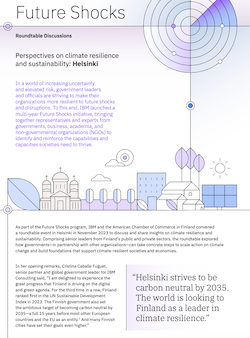
Perspectives on climate resilience and sustainability

Since the turn of the millennium, pandemics, heat waves, wildfires, floods, cyberattacks, supply chain interruptions, and other crises have deeply stressed governments, communities, businesses, and individuals around the world. This cascade of catastrophic events raises fundamental questions about how governments can anticipate, prepare for, and respond to these and other shocks yet to come.
What practical steps can governments take in the near term to better prepare for and respond to future shocks? Our Center, in partnership with the National Academy of Public Administration, and working through the IBM Institute for Business Value launched an initiative to help governments identify core capabilities critical to building resilience. (Learn more about our Future Shocks series.)
In addition to the climate resilience roundtable held in the United States, together with the American Chamber of Commerce in Finland, we convened a roundtable event in Helsinki to discuss and share insights on climate resilience and sustainability. Comprising senior leaders from Finland’s public and private sectors, the roundtable explored how governments—in partnership with other organizations—can take concrete steps to scale action on climate change and build foundations that support climate-resilient societies and economies.
For the third time in a row, Finland ranked first in the UN Sustainable Development Index in 2023. The Finnish government also set the ambitious target of becoming carbon neutral by 2035—a full 15 years before most other European countries and the EU as an entity. And many Finnish cities have set their goals even higher.
Government has a key role to play in building and maintaining momentum on sustainability and climate resilience. But to fulfill this role, its leaders must shift their thinking in how governments operate. They need to break down the silos between departments to achieve integrated action for a sustainable transition. This step needs to cover both the environmental and social aspects of sustainability.
Learn the steps government can take to tackle sustainability efforts.



